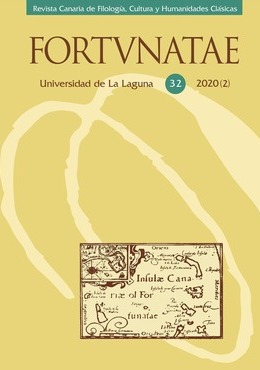Some thoughts on ‘philohellenism’ and homeric scholia
Abstract
Iliad’s ancient commentators replaced the Homeric dichotomy “Achaeans vs. Trojans” with “Greeks vs. Barbarians”. Modern scholars no longer call the Trojans ‘barbarians’; but they usually oppose Trojans and ‘Greeks’, dispensing with the original denominations of Achaeans, Danaans, etc. This distortion is not innocuous: it assumes without discussion that the Iliad’s ancient audiences experienced a special affinity for one side and identified it with “our side”. It is not impossible that this feeling existed at times; but it is abusive to interpret it in an ethnic, national or ‘patriotic’ sense. However, this is what the Scholia usually do, seriously distorting, in many cases, the original text.
References
BIARDEAU, M. (2002): Le Mahābhārata. Un récit fondateur de brahmanisme et son interprétation (2 vols.), Éditions du Seuil, Paris.
BRELICH, A. (1958): Gli eroi greci. Un problema storico-religioso, Ateneo, Roma.
BURKERT, W. (1966): «Kekropidensage und Arrhephoria. Vom Initiationsritus zum Panathenäenfest», Hermes XCIV: 1-25.
BURKERT, W. (2001): Kleine Schriften I. Homerica, ed. Ch. RIEDWEG, Vandenhoeck und Rupprecht, Göttingen.
CALAME, C. (1987): «Spartan Genealogies: The Mythological Representation of a Spatial Organisation», en J. BREMMER (ed.), Interpretations of Greek Mythology, Croom Helm, London & Sidney, pp. 153-186.
CALAME, C. (1996): «Feste, ritieforme poetiche»,en S. SETTIS (ed.), I Greci. 2. Una Storia greca. I. Formazione (fino al VI secolo a. C.), Einaudi, Torino, pp. 470-496.
CLAY, J. S. (1989): The Politics of Olympus. Form and Meaning in the Major Homeric Hymns, Princeton University Press, Princeton NJ.
DAVISON, J. A. (1958): «Notes on the Panathenaea», JHS LXXVIII: 23-42.
DETIENNE, M. (2003): Comment être autochtone, Seuil, Paris.
DICKEY, E. (2007): Ancient Greek Scholarship, American Philological Association / Oxford University Press.
DUMÉZIL G. (1995): Mythe et Épopée I. II. III, Gallimard, Paris.
EDWARDS, M. W. (1991): The Iliad: A Commentary. Volume V: Books 17-20, Cambridge University Press.
FAULKNER, A. (2008): The Homeric Hymn to Aphrodite. Introduction, Text, and Commentary, Oxford University Press.
GRAZIOSI, B. (2002): Inventing Homer. The Early Reception of Epic, Cambridge University Press.
HALL, E. (1989): Inventing the Barbarian. Greek Self-Definition throughTragedy, Clarendon Press, Oxford.
HALL, J. M. (1997): Ethnic Identity in Greek Antiquity, Cambridge University Press.
HALL, J. M. (2002). Hellenicity. Between Ethnicity and Culture, The University of Chicago Press, Chicago - London.
HASLAM, M. (1997): «Homeric Papyri and the Transmission of the Text», en I. MORRIS & B. POWELL (eds.), A New Companion to Homer, Brill, Leiden - New York, pp. 55-100.
ERBSE, H.(1969-1988): Scholia graeca in HomeriIliadem. Scholia vetera.(7 vols.),Walter de Gruyter, Berlin.
JENSEN, M. S. (1980): The Homeric Question and the Oral-FormulaicTheory, MuseumTusculanum Press, Copenhagen.
KAKRIDIS, J. T. (1971): Homer Revisited, Gleerup, Lund.
KIRK, G. S. (1985): The Iliad: A Commentary. Volume I: Books 1-4, Cambridge University Press. LORAUX, N. (19902): Les enfants d’Athéna. Idées athéniennes sur la citoyenneté et la division des sexes, La Découverte/Seuil, Paris.
MACKIE, H. (1996): Talking Trojan. Speech and Community in the Iliad, Rowman & Littlefield, Lanham - Boulder - New York - London.
NAGY, G. (2002): Plato’s Rhapsody and Homer’s Music. The Poetics of the Panathenaic Festival in Classical Athens, Center for Hellenic Studies / Harvard University Press, Washington - Athens.
NAGY, G. (2004): Homer’s Text and Language, University of Illinois Press, Urbana - Chicago.
NAGY, G. (2010): Homer the Preclassic, University of California Press, Berkeley - Los Angeles - London.
NAGY, G. (2013): The Ancient Greek Hero in 24 Hours, The Belknap Press - Harvard University Press, Cambridge (MA) - London.
NEILS, J. (1992): Goddess and Polis.The Panathenaic Festival in Ancient Athens, Princeton University Press, Princeton NJ.
NENCI, G. (1994): ERODOTO. Le Storie. Libro V. La rivolta della Ionia. Fondazione Lorenzo Valla, Arnoldo Mondadori, Verona.
PÒRTULAS, J. (2008): Introducció a la Ilíada. Homer entre la història i la llegenda, Fundació Bernat Metge, Barcelona.
PINSENT, J. (1984): «The Trojans in the Iliad», en L. FOXHALL - J. K. DAVIES (eds.), The Trojan War. Its Historicity and Context, Bristol Classical Press, Bristol, pp. 141-162.
REINHARDT, K. (1956): «Zum homerischen Aphroditehymnus», en Festschrift für Bruno Snell zum 60. Geburtstag, von Freunden und Schülern überreicht, Beck, München, pp. 1-14.
REINHARDT, K. (1961): Die Ilias und ihr Dichter. Herausgegeben VON U. HÖLSCHER, Vandenhoeck und Rupprecht, Göttingen.
RICHARDSON, N. J. (1980): «Literary Criticism in the Exegetical Scholia to theIliad: A Sketch», CQ XXX: 265-287.
SABBATUCCI, D. (1978): Il mito, il rito e la storia, Bulzoni Editore, Roma.
SEAFORD, R. (1994): Reciprocity and Ritual. Homer and Tragedy in the Developing City-State, Clarendon Press, Oxford.
SCHIRONI, F. (2018): The Best of the Grammarians. Aristarchus of Samothrace on the Iliad, University of Michigan Press, Ann Arbor.
SMITH, P. M. (1981): «Aineiadai as Patrons of Iliad XX and the Homeric Hymn to Aphrodite», HSCP LXXXV: 17-58.
SVENBRO, J. (1984): La parola e il marmo. Alle origini della poetica greca, Boringhieri, Torino.
TAPLIN, O. (1990): «Agamemnon’s Role in the Iliad», en C. PELLING (ed.), Characterization and Individuality in Greek Literature, Clarendon Press, Oxford, pp. 60-82.
VIAN, F. (1963): Les origines de Thèbes. Cadmos et les Spartes, Klincksieck, Paris.
VAN DER VALK, M. (1953): «Homer’s Nationalistic Attitude», AC XXII: 5-26.
VAN DER VALK, M. (1985): «Homer’s Nationalism, again», Mnemosyne XXXVIII: 373-376.
WEST, M. L. (2011): The Making of the Iliad. Disquisition and Analitical Commentary, Oxford University Press.
WEST, S. R.(1988): «TheTransmission of theText», en A. HEUBECK, S.R.WEST & J. B. HAINSWORTH, A Commentary on Homer’s Odyssey. Volume I. Introduction and Books I-VIII, Clarendon Press, Oxford, pp. 33-48.
Authors retain copyright and grant the journal the right to be the first publication of the work as well as license it under a Creative Commons Attribution License that allows others to share the work with acknowledgment of authorship of the work and initial publication in this magazine.
Authors may separately establish additional agreements for the non-exclusive distribution of the version of the work published in the journal (for example, placing it in an institutional repository or publishing it in a book), with an acknowledgment of its initial publication in this journal.





